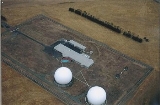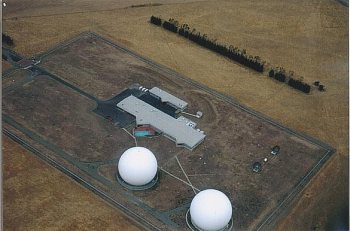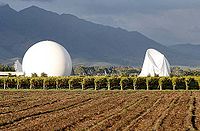
Government Communications Security Bureau
Encyclopedia

Intelligence agency
An intelligence agency is a governmental agency that is devoted to information gathering for purposes of national security and defence. Means of information gathering may include espionage, communication interception, cryptanalysis, cooperation with other institutions, and evaluation of public...
of the New Zealand
New Zealand
New Zealand is an island country in the south-western Pacific Ocean comprising two main landmasses and numerous smaller islands. The country is situated some east of Australia across the Tasman Sea, and roughly south of the Pacific island nations of New Caledonia, Fiji, and Tonga...
government.
The mission statement is given as:
To contribute to the national security of New Zealand through:
- providing foreign signals intelligence to support and inform Government decision making;
- providing an all-hours foreign intelligence watch and warning service to Government;
- ensuring the integrity, availability and confidentiality of official information through information systems security services to Government; and
- assisting in the protection of the national critical infrastructure from information-borne threats.
Operations
The functions of the GCSB include signals intelligence, communications securityCommunications security
Communications security is the discipline of preventing unauthorized interceptors from accessing telecommunications in an intelligible form, while still delivering content to the intended recipients. In the United States Department of Defense culture, it is often referred to by the abbreviation...
, anti-bugging measures
Technical Surveillance Counter-Measures
TSCM is the original United States Federal government abbreviation denoting the process of bug-sweeping or electronic countersurveillance...
, and computer security
Computer security
Computer security is a branch of computer technology known as information security as applied to computers and networks. The objective of computer security includes protection of information and property from theft, corruption, or natural disaster, while allowing the information and property to...
.
For the purposes of its signals intelligence activities, the GCSB maintains two "listening stations"; a satellite communications interception station at Waihopai
GCSB Waihopai
New Zealand's Government Communications Security Bureau operates what it describes as a satellite communications monitoring facility in the Waihopai Valley...
and a radio communications interception station at Tangimoana
GCSB Tangimoana
The New Zealand Government Communications Security Bureau operates what it describes as a radio communications interception facility at Tangimoana, 30 kilometres west of Palmerston North, in New Zealand....
. The Waihopai station has been operating since 1989, and was expanded with the construction of a second interception dish in 1998. The Tangimoana station was opened in 1982, replacing an earlier facility at Irirangi, near Waiouru
Waiouru
Waiouru is a small town in the centre of the North Island of New Zealand. It is on the North Island Volcanic Plateau, 25 kilometres south-east of Mount Ruapehu, and in the Ruapehu District....
.
The GCSB does not publicly disclose the nature of the communications which it intercepts. It is frequently described by some authors, such as Nicky Hager
Nicky Hager
Nicky Hager is an author and investigative journalist born in Levin, New Zealand and now resides in Wellington. He generally writes about issues involving intelligence networks, environmental issues and politics. He has degrees in physics and philosophy...
, as part of ECHELON
ECHELON
ECHELON is a name used in global media and in popular culture to describe a signals intelligence collection and analysis network operated on behalf of the five signatory states to the UK–USA Security Agreement...
. In 2006, after the death of former Prime Minister David Lange
David Lange
David Russell Lange, ONZ, CH , served as the 32nd Prime Minister of New Zealand from 1984 to 1989. He headed New Zealand's fourth Labour Government, one of the most reforming administrations in his country's history, but one which did not always conform to traditional expectations of a...
, a 1985–86 report given to Lange was found among his papers, having been mistakenly released. The report listed a number of countries as targets of GCSB efforts, including Japan
Japan
Japan is an island nation in East Asia. Located in the Pacific Ocean, it lies to the east of the Sea of Japan, China, North Korea, South Korea and Russia, stretching from the Sea of Okhotsk in the north to the East China Sea and Taiwan in the south...
, the Philippines
Philippines
The Philippines , officially known as the Republic of the Philippines , is a country in Southeast Asia in the western Pacific Ocean. To its north across the Luzon Strait lies Taiwan. West across the South China Sea sits Vietnam...
, Argentina
Argentina
Argentina , officially the Argentine Republic , is the second largest country in South America by land area, after Brazil. It is constituted as a federation of 23 provinces and an autonomous city, Buenos Aires...
, France
France
The French Republic , The French Republic , The French Republic , (commonly known as France , is a unitary semi-presidential republic in Western Europe with several overseas territories and islands located on other continents and in the Indian, Pacific, and Atlantic oceans. Metropolitan France...
, Vietnam
Vietnam
Vietnam – sometimes spelled Viet Nam , officially the Socialist Republic of Vietnam – is the easternmost country on the Indochina Peninsula in Southeast Asia. It is bordered by China to the north, Laos to the northwest, Cambodia to the southwest, and the South China Sea –...
, and many small Pacific island
Pacific Islands
The Pacific Islands comprise 20,000 to 30,000 islands in the Pacific Ocean. The islands are also sometimes collectively called Oceania, although Oceania is sometimes defined as also including Australasia and the Malay Archipelago....
states. It also mentioned United Nations
United Nations
The United Nations is an international organization whose stated aims are facilitating cooperation in international law, international security, economic development, social progress, human rights, and achievement of world peace...
diplomatic traffic. In his book on the GCSB, Nicky Hager says that during the Cold War
Cold War
The Cold War was the continuing state from roughly 1946 to 1991 of political conflict, military tension, proxy wars, and economic competition between the Communist World—primarily the Soviet Union and its satellite states and allies—and the powers of the Western world, primarily the United States...
, the locations and activities of Soviet
Soviet Union
The Soviet Union , officially the Union of Soviet Socialist Republics , was a constitutionally socialist state that existed in Eurasia between 1922 and 1991....
ships (including civilian craft such as fishing trawlers) were a major focus of the organisation's activities.
History
The Government Communications Security Bureau was created in 1977 on the instructions of Robert MuldoonRobert Muldoon
Sir Robert David "Rob" Muldoon, GCMG, CH served as the 31st Prime Minister of New Zealand from 1975 to 1984, as leader of the governing National Party. Muldoon had been a prominent member of the National party and MP for the Tamaki electorate for some years prior to becoming leader of the party...
, the Prime Minister
Prime Minister of New Zealand
The Prime Minister of New Zealand is New Zealand's head of government consequent on being the leader of the party or coalition with majority support in the Parliament of New Zealand...
. Prior to this, the functions now handled by the GCSB were split between three different organisations:
- Communications security was the responsibility of the Communications Security Committee, based around the Prime Minister's office and the Ministry of Foreign AffairsNew Zealand Ministry of Foreign Affairs and TradeThe New Zealand Ministry of Foreign Affairs and Trade is the New Zealand Government ministry responsible for promoting New Zealand's interests in trade and international relations....
. - Signals intelligence was the responsibility of the Combined Signals Organisation, run by the military.
- Anti-bugging measures were the responsibility of the Security Intelligence ServiceNew Zealand Security Intelligence ServiceThe New Zealand Security Intelligence Service is an intelligence agency of the New Zealand government.-Purpose:As a civilian organisation, the Security Intelligence Service takes no part in the enforcement of security...
.
Upon its establishment, the GCSB assumed responsibility for these three roles. Officially, the new organisation was part of the Ministry of Defence, and its functions and activities were highly secret even Cabinet
New Zealand Cabinet
The Cabinet of New Zealand functions as the policy and decision-making body of the executive branch within the New Zealand government system...
was not informed. In the 1980s, however, information was gradually released, first about the GCSB's security role, and then about its signals intelligence operations.

In 2001, the Centre for Critical Infrastructure Protection
Centre for Critical Infrastructure Protection
The Centre for Critical Infrastructure Protection is an organisational unit of New Zealand's Government Communications Security Bureau...
was formed within the GCSB with a mandate to assist in the protection of national critical infrastructure
Critical infrastructure
Critical infrastructure is a term used by governments to describe assets that are essential for the functioning of a society and economy. Most commonly associated with the term are facilities for:*electricity generation, transmission and distribution;...
from information borne threats.
On 30 April 2008 one of the domes of the Waihopai Spy Base
GCSB Waihopai
New Zealand's Government Communications Security Bureau operates what it describes as a satellite communications monitoring facility in the Waihopai Valley...
was attacked with sickles by activists causing an estimated NZ$1 million damage. The activists readily admitted the attack in court but were found not guilty due to their defence of claim of right.
Organisation
The GCSB is considered to be a government department in its own right. The GCSB reports to the ministerMinister (government)
A minister is a politician who holds significant public office in a national or regional government. Senior ministers are members of the cabinet....
holding the Intelligence
Intelligence (information gathering)
Intelligence assessment is the development of forecasts of behaviour or recommended courses of action to the leadership of an organization, based on a wide range of available information sources both overt and covert. Assessments are developed in response to requirements declared by the leadership...
portfolio, who, by convention, is always the Prime Minister
Prime Minister of New Zealand
The Prime Minister of New Zealand is New Zealand's head of government consequent on being the leader of the party or coalition with majority support in the Parliament of New Zealand...
. Internally, it is split into five divisions:
- Collection and processing of intelligence
- Distribution of intelligence to those needing it
- IT security
- Technology
- Administration
Director
The GCSB is administered by a Director. There have been four directors to date:- Colin Hanson (1977–1988)
- Ray Parker (1988–1999)
- Dr Warren TuckerWarren TuckerWarren Tucker is a senior New Zealand intelligence officer. He is currently director of the Security Intelligence Service.Tucker was originally an officer in the New Zealand Army, holding the rank of Major...
(1999–2006) - Air Marshal Sir Bruce FergusonBruce FergusonAir Marshal Sir Bruce Reid Ferguson KNZM, OBE, AFC is the former Chief of New Zealand Defence Force and Director of Government Communications Security Bureau. He took up the appointment when the previous Director Dr. Warren Tucker, took up his new role as Director of Security Intelligence Service...
(2006 – 2011) - Lieutenant General Sir Jerry MateparaeJerry MateparaeLieutenant General Sir Jeremiah "Jerry" Mateparae, GNZM, QSO is New Zealand's 20th Governor-General. He was Chief of the New Zealand Defence Force between 2006 and 2011, the first Māori person to hold the office, and the Director of the New Zealand Government Communications Security Bureau from 7...
(2011) - Simon MurdochSimon MurdochSimon Murdoch, CNZM is a New Zealand diplomat and public servant. He was New Zealand’s Secretary of Foreign Affairs and Trade and was previously New Zealand High Commissioner to Canberra, and Chief Executive of the Department of Prime Minister and Cabinet.-Early life and education:Murdoch attended...
(acting, July 2011)
Lieutenant General Jerry Mateparae was appointed by Prime Minister John Key on the 26 August 2010 taking up the role on 7 February 2011. However, on 8 March 2011 Mataparae was announced as New Zealand's next Governor-General
Governor-General of New Zealand
The Governor-General of New Zealand is the representative of the monarch of New Zealand . The Governor-General acts as the Queen's vice-regal representative in New Zealand and is often viewed as the de facto head of state....
. He continued as Director until June 2011.
Thus far, all directors of the GCSB have had a military career before joining the organisation Hanson, Parker, and Ferguson were all Air Force
Royal New Zealand Air Force
The Royal New Zealand Air Force is the air arm of the New Zealand Defence Force...
officers (the latter serving as Chief of Defence), and Tucker was an Army
New Zealand Army
The New Zealand Army , is the land component of the New Zealand Defence Force and comprises around 4,500 Regular Force personnel, 2,000 Territorial Force personnel and 500 civilians. Formerly the New Zealand Military Forces, the current name was adopted around 1946...
officer.
See also
- New Zealand intelligence agenciesNew Zealand intelligence agenciesNew Zealand's intelligence agencies and units have existed, with some interruption, since World War II. At present, New Zealand's intelligence community has approximately 500 employees, and has a combined budget of around NZ$80 million.-Standalone agencies:...
- New Zealand Security Intelligence ServiceNew Zealand Security Intelligence ServiceThe New Zealand Security Intelligence Service is an intelligence agency of the New Zealand government.-Purpose:As a civilian organisation, the Security Intelligence Service takes no part in the enforcement of security...
- Centre for Critical Infrastructure ProtectionCentre for Critical Infrastructure ProtectionThe Centre for Critical Infrastructure Protection is an organisational unit of New Zealand's Government Communications Security Bureau...

